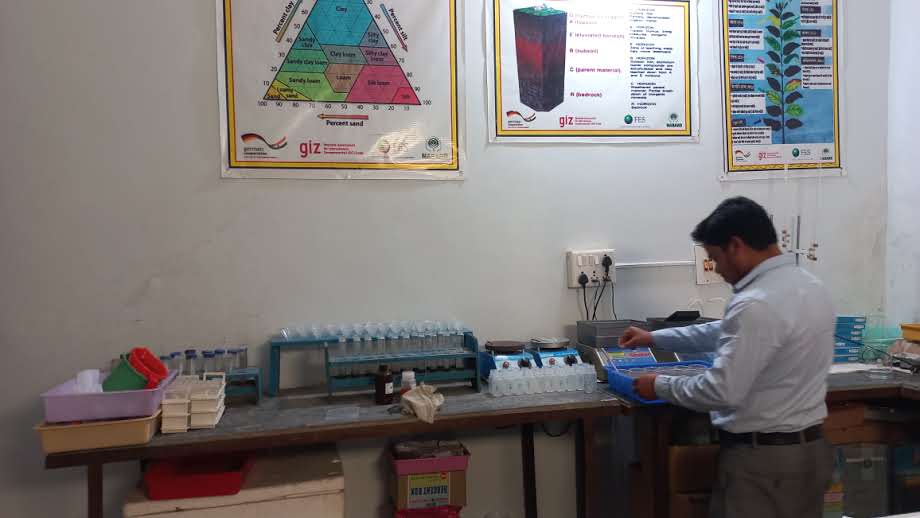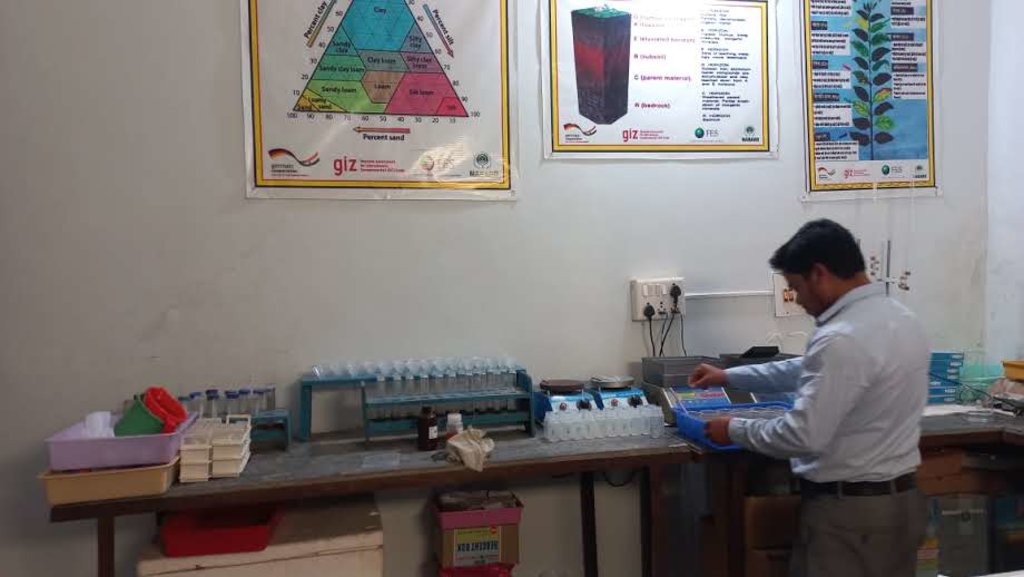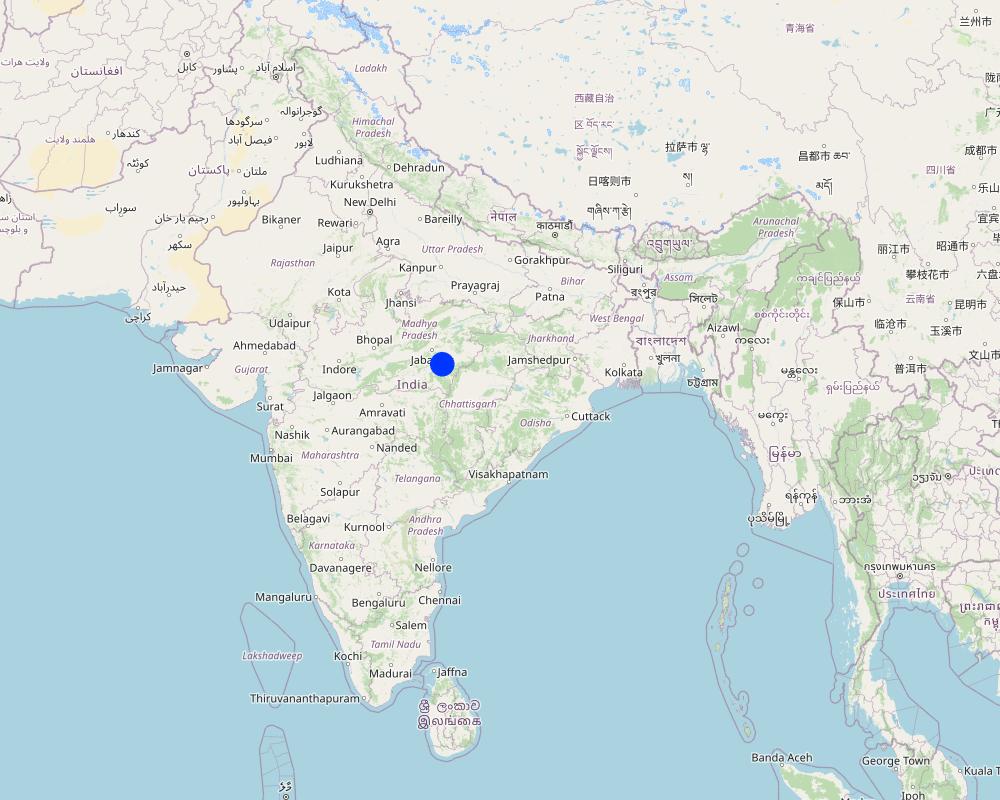Dissemination of Soil Test Results to Farmers through a Participatory Approach [印度]
- 创建:
- 更新:
- 编制者: Santosh Gupta
- 编辑者: Noel Templer, Stephanie Katsir
- 审查者: Udo Höggel, Joana Eichenberger
Mitti ki namuna
approaches_6698 - 印度
- Dissemination of Soil Test Results to Farmers through a Participatory Approach: June 18, 2023 (inactive)
- Dissemination of Soil Test Results to Farmers through a Participatory Approach: Sept. 14, 2023 (inactive)
- Dissemination of Soil Test Results to Farmers through a Participatory Approach: April 11, 2024 (public)
查看章节
全部展开 全部收起1. 一般信息
1.2 参与方法评估和文件编制的资源人员和机构的联系方式
有助于对方法进行记录/评估的项目名称(如相关)
Soil protection and rehabilitation for food security (ProSo(i)l)有助于对方法进行记录/评估的机构名称(如相关)
Deutsche Gesellschaft für Internationale Zusammenarbeit (GIZ)有助于对方法进行记录/评估的机构名称(如相关)
Alliance Bioversity and International Center for Tropical Agriculture (Alliance Bioversity-CIAT) - 肯尼亚有助于对方法进行记录/评估的机构名称(如相关)
Ecociate Consultants (Ecociate Consultants) - 印度1.3 关于使用通过WOCAT记录的数据的条件
(现场)数据是什么时候汇编的?:
22/02/2023
编制者和关键资源人员接受有关使用通过WOCAT记录数据的条件。:
是
2. SLM方法的描述
2.1 该方法的简要说明
A systematic approach has been developed under the project for collecting soil samples, conducting the soil test results, issuing soil health cards, building the capacity of farmers to interpret the soil health card and apply the required nutrients to the soil based on the soil test result
2.2 该方法的详细说明
该方法的详细说明:
Soil testing is a pre-cultivation activity that gives a good idea about soil structure and mineral composition ratios. The essential nutrients required for various crop growths can be estimated during soil testing. The Foundation for Ecological Security (FES) has established a state-of-the-art soil testing laboratory for testing soil samples in India's Mandla District of Madhya Pradesh. The soil test lab was established in 2016 with a capacity to test 1500-2000 soil samples every year. Based on a soil sampling process, it takes around 2 days to generate the soil test results for 20 soil samples. Collected soil samples are tested for 12 parameters. These parameters include Soil Ph, Soil organic carbon (SoC), electrical conductivity (EC), major nutrients like nitrogen(N), phosphorus (P), potassium (K), secondary nutrients like sulphur, magnesium, iron, boron, zinc, manganese, and copper. Based on the soil test report, farmers are issued a soil health card with crop-specific recommendations for additional chemical and organic inputs into the soil.
To ensure the accuracy of the sampling process and proper dissemination of generated results among the farmers, FES has developed a very systematic process which consists of:
•the collection of soil samples
•the analysis of collected soil samples in an FES lab
•the issuance of soil health cards
•the interpretation of soil test results
•noticing of test results to farmers
•farmers are able to implement practices, recommended by the test result
The entire process, from soil sampling to dissemination, is briefly mentioned below:
•Developing the grids for a random collection of soil samples: The first step is to develop a geographical grid for collecting random samples based on predefined parameters. In the irrigated areas, samples are drawn in a grid of 2.5 ha, while in rainfed areas, samples are drawn from a grid of 10 ha. While developing the grid, farmers' fields are categorized into the following parameters. Each of the parameters is assigned a specific score, and based on the obtained score, each farmer’s land is given a specific number for easy identification on soil maps. These include the a) type of soil, b) type of field, e.g., upland, medium land, or low land, c) crop cycle (Single crop, multiple crops) d) The slope of the field. This entire exercise is a soil survey exercise used to develop soil maps for each geographical unit village, block, district.
•Collection of soil samples: From each classified grid, soil samples are collected from 5 different locations between the harvest of one crop and the sowing/planting of another crop when fields are vacant. The soil samples are collected at a depth of 5 to 15 cm. All the collected soil samples are mixed repeatedly, and a portion of the collected soil is kept aside each time. The mixing process is followed 5-6 times to ensure collected soil samples represent the entire area. Finally, around 500 gm of soil is packed in plastic polythene based on the above grid parameters.
•Soil sample analysis: Collected soil samples are transported to the centralized soil test lab in Mandla (MP) for testing and analysis. The samples are analyzed by qualified lab personnel. The analysis process for the above mentioned 12 parameters takes around 2 days (considering 8-9 working hours in a day).
•Issuance of soil health card: Based on the results obtained from the analysis, soil health cards are issued to farmers. The soil health card contains the following information in the local language (Hindi) so that farmers understand the test results and their implications:
a.Basic details of the farmer: name, address, soil grid, GPS coordinates, field identification number, etc.
b.Soil test results for above mentioned 12 parameters: results of the soil test in their respective units, standard numbers, grading of the obtained result (acidic/saline for PH., high, medium, low for other parameters)
c.Crop-wise soil correction recommendations for major crops: recommendations for synthetic fertilizers, biofertilizers, and compost
d.Pre-printed information with photos for identification of nutrient deficiency in the crops.
•Dissemination of soil health card to farmers: To ensure that farmers understand the results and implement the practices at their field, local community resource persons reach out to every farmer to make them understand the soil test results and closely monitor their farmers’ practices across the crop stages. Farmers are also encouraged to maintain farm diaries for their practices. They are also trained in the preparation of various bio-inputs and compost for application in their field.
2.3 该方法的照片
2.5 采用该方法的国家/地区/地点
国家:
印度
区域/州/省:
Madhya Pradesh
有关地点的进一步说明:
Mandla
注释:
Mandla, Madhya Pradesh, India
Map
×2.6 该方法的开始和终止日期
注明开始年份:
2018
2.7 方法的类型
- 基于项目/方案
2.8 该方法的主要目的/目标
1. Ensure judicious usage of fertilizers and micronutrients based on the requirement of the soil
2. Ensure quality soil testing and dissemination of results
3. Build farmers' capacity for interpretation of soil health cards
4. Develop soil maps based on the in-house results from the soil test lab
2.9 推动或妨碍实施本办法所适用的技术的条件
机构设置
- 启动
The entire dissemination methodology is done through community-based organizations
参与者的的协作/协调
- 启动
Several stakeholders, such as FES, farmers, equipment suppliers, the scientific community, and soil scientists, are involved in the project
政策
- 启动
Soil test results are an excellent input for the agricultural policies around fertilizers, farming practices, and soil health-related policies
土地治理(决策、实施和执行)
- 启动
A soil health card is an excellent tool for farmers to decide on the usage of fertilizers and the kind of farming practices to implement
了解SLM,获得技术支持
- 启动
Soil health cards inform the farmers and the project management team so to decide on required interventions and farming practices
市场(购买投入,销售产品)和价格
- 启动
Very much relevant as soil test results quantify the number of farm inputs to be applied to the farm
3. 相关利益相关者的参与和角色
3.1 该方法涉及的利益相关者及其职责
- 当地土地使用者/当地社区
Farmers from the project area
Soil samples were collected from the field of farmers. They have actively participated in the projects for managing the soil samples, participating in the capacity building programs, and implementing the recommended practices.
- 社区组织
FES, the implementing NGO, have formed the Villages Environment Committee (VEC) in their project villages as community-based organizations
VECs facilitated the implanting of a project by mobilizing the communities as and when needed. FES reached farmers through the VECs, to collect the soil samples or disseminate the information. VECs also facilitated community-level implementation activities.
- SLM专家/农业顾问
SLM Specialist
Documentation of the activities
- NGO
Foundation for Ecological Security (FES) is a well-known NGO registered in India. It focuses on ecology-related issues and works closely with farmers and forest-based communities.
FES played an essential role in the project. Primary activities were as follows:
1. Establishment of soil testing laboratory and hiring the technical team to conduct the soil test lab
2. Collection of soil test samples and building the capacity of farmers on soil sample collection
3. Conducting soil test results and issuance of soil health cards to farmers
4. Developing a soil health map for the project areas
5. Capacity building of farmers for the interpretation of soil health cards and ensuring the implementation of recommended practices
- 国际组织
GIZ, India
Funding of the project
如果涉及多个利益相关者,请注明领导机构:
Foundation for Ecological Security
3.2 当地土地使用者/当地社区参与该方法的不同阶段
| 当地土地使用者/当地社区的参与 | 指定参与人员并描述活动 | |
|---|---|---|
| 启动/动机 | 被动 | The FES led the initiation of discussions with its donor organizations. Discussions with communities to understand the challenges and opportunities. |
| 计划 | 互动 | Local community institutions played a significant role in the entire process of planning and execution |
| 实施 | 互动 | Farmers and community-based institutions were actively involved in implementing multiple activities under the project, such as collecting soil samples, supplying them to the soil test labs, and Implementing the recommended practices. |
| 监测/评估 | 互动 | Community-based institutions played an important role in monitoring individual farmers for implementing the recommendations provided to farmers. They also monitored the results regarding crop progress, crop productivity, and improvement in soil health status. |
3.4 有关SLM技术选择的决策
具体说明谁有权决定选择要实施的技术:
- 所有相关参与者,作为参与式方法的一部分
解释:
All actors, including the farmers, CBO, NGO, and soil scientists, mutually discussed and decided on the implementation of technology as all stakeholders were equally crucial for the effective and result-oriented implementation of the technology.
明确做出决策的依据:
- 对充分记录的SLM知识进行评估(基于证据的决策)
- 研究结果
4. 技术支持、能力建设和知识管理
4.1 能力建设/培训
是否为土地使用者/其他利益相关者提供培训?:
是
明确受训人员:
- 土地使用者
- 现场工作人员/顾问
如果相关,请说明性别、年龄、地位、种族等。:
Both male and female farmers in all age groups were trained under the project. The majority of the farmers were from tribal communities.
培训形式:
- 农民对农民
- 示范区域
- 公开会议
涵盖的主题:
1. Importance of soil testing for the judicious use of fertilizers
2. Methods for soil sample collection
3. Interpretation of soil health card
4. Dissemination of soil test results and ways and means for implementing the recommended practices following organic and non-organic implementation practices
4.2 咨询服务
土地使用者有权使用咨询服务吗?:
是
指明是否提供了咨询服务:
- 在土地使用者的土地上
说明/注释:
FES has a team of community-based resource persons from the local community and villages to provide advisory services to farmers
4.3 机构强化(组织发展)
是否通过这种方法建立或加强了机构?:
- 是,非常
具体说明机构的强化或建立程度:
- 本地
说明机构、角色和职责、成员等。:
Village-level environment committees were formed to discuss the issues related to environmental concerns, livelihoods, and other social problems at the village level. These committees consist of male and female members representing the entire village.
具体说明支持类型:
- 财务
- 能力建设/培训
提供进一步细节:
These committees were provided financial support to implement the identified activities based on the provision under the project and proposals submitted by the local committees. FES regularly provides training and handholding support to these committees.
4.4 监测和评估
监测和评估是该方法的一部分吗?:
是
注释:
The soil health report card is very useful in monitoring of the status of soil health and measuring the impact of various practices and intervention
若是,该文件是否用于监测和评估?:
否
4.5 研究
研究是该方法的一部分吗?
是
明确话题:
- 生态学
- 技术
5. 融资和外部物质支持
5.1 该方法中SLM组成部分的年度预算
如果不知道准确的年度预算,请给出一个范围:
- 2,000-10,000
注释(例如主要的资助来源/主要捐助者):
Externally funded projects (GIZ)
5.2 为土地使用者提供财政/物质支援
土地使用者是否获得实施该技术的财政/物质支持?:
否
5.3 对特定投入的补贴(包括劳动力)
- 设备
| 具体说明哪些投入得到了补贴 | 程度如何 | 对补贴做出具体说明 |
|---|---|---|
| 机械 | 部分融资 | Different equipment used for testing the soils |
| 工具 | 部分融资 | Different tools are used for collecting soil samples and for soil testing |
如果土地使用者的劳动力是一项重要的投入,那么是不是:
- 自愿
5.4 信用
是否根据SLM活动的方法给予信用值?:
否
5.5 其它激励或手段
是否有其他激励措施或工具用于促进SLM技术的实施?:
否
6. 影响分析和结论性陈述
6.1 方法的影响
这种方法是否有助于基于证据的决策?:
- 否
- 是,很少
- 是,中等
- 是,支持力度很大
Soil health card-based changes in soil management and developing the evidence for soil health monitoring
该方法是否提高了SLM的协调性和成本效益?:
- 否
- 是,很少
- 是,中等
- 是,支持力度很大
Reduced the cost of applying fertilizers and other inputs through a result-based application
该方法是否提高了土地使用者实施土地管理的知识和能力?:
- 否
- 是,很少
- 是,中等
- 是,支持力度很大
Training and handholding by the team of implementing partners have helped land users to interpret the result of soil health card, collection of soil samples and following the recommended practices
该方法是否提高了其他利益相关者的知识和能力?:
- 否
- 是,很少
- 是,中等
- 是,支持力度很大
Other stakeholders such as implementing team got information about the outcome of their practices. More importantly, the soil health card was helpful in providing precise information on the application of fertilisers and bio-inputs.
该方法是否鼓励年轻人/下一代土地使用者参与SLM?:
- 否
- 是,很少
- 是,中等
- 是,支持力度很大
Youths were greatly involved in collection of soil samples
6.2 土地使用者实施SLM的主要动机
- 增加利润(能力),提高成本效益比
With soil test results, land users now need to apply only the required nutrients in a specific quantity. This reduced the cost of soil management and fertilisers.
- 减少土地退化
Soil test results were helpful in preventing and reducing the non-judicious usage of synthetic fertilisers, which was among the major reasons for land degradation in the project area. Also recommendations for both organic and synthetic fertilisers based on the soil health cards helped farmers in replacing synthetic fertilisers with organic fertilisers.
- 环境意识
6.3 方法活动的可持续性
土地使用者能否维持通过该方法实施的措施(无外部支持的情况下)?:
- 是
若是,请说明如何维持:
Yes. The benefit in both reduced cost and improved soil health are the triggers to sustaining the practices. Also, the involvement of local community institutions will also ensure the sustainability of interventions.
6.4 该方法的长处/优点
| 土地使用者眼中的长处/优势/机会 |
|---|
| Judicious use of fertilizers and pesticides based on the nutrient requirement of soil, as mentioned under the soil health report |
| Separate recommendations for both chemical and organic (bio-inputs) are a good way for land users to make informed decisions |
| Tracing the improvement in soil health status based on the land users' agricultural practices |
| 编制者或其他关键资源人员认为的长处/优势/机会 |
|---|
| Developing the soil maps for the entire area to design appropriate interventions for the project |
| Instead of general recommendations for input application, the soil health card helped develop farmer/village-centric extension services for the farmers |
| Understand the impact of various interventions through periodic soil testing to document what has worked and what has not. Even this evidence can be used to monitor the soil organic carbon content for designing carbon-based projects and/or to access national or international carbon reduction credits. |
6.5 该方法的弱点/缺点以及克服它们的方法
| 土地使用者认为的弱点/缺点/风险 | 如何克服它们? |
|---|---|
| Farmers are still unaware of the soil test facility and its benefits | Regular awareness programs along with a demonstration of soil sample collection |
| 编制者或其他关键资源人员认为的弱点/缺点/风险 | 如何克服它们? |
|---|---|
| Farmers' strong belief in the application of a certain quantity of fertilizers to ensure better production | This requires specific behavior change campaigns through local demonstration and documentation |
| Government authorities also conduct the soil test and issue the soil health card. However the farmers' experience with such system has not been outstanding. | Put efforts into conveying the difference between both approaches by promptly issuing the soil health card |
| The soil test lab is in the District capital, so farmers in far-away areas may face difficulties in accessing the facility | Explore the option of establishing soil test labs near farmers' locations |
7. 参考和链接
7.1 方法/信息来源
- 实地考察、实地调查
1
- 与土地使用者的访谈
5
- 与SLM专业人员/专家的访谈
2
- 根据报告和其他现有文档进行编译
3
7.3 链接到网络上可用的相关信息
标题/说明:
Operational Guidelines for implementation of CENTRALLY SPONSORED SCHEME SOIL HEALTH CARD
URL:
https://agricoop.nic.in/sites/default/files/GSHC3.pdf
链接和模块
全部展开 全部收起链接
无链接
模块
无模块







